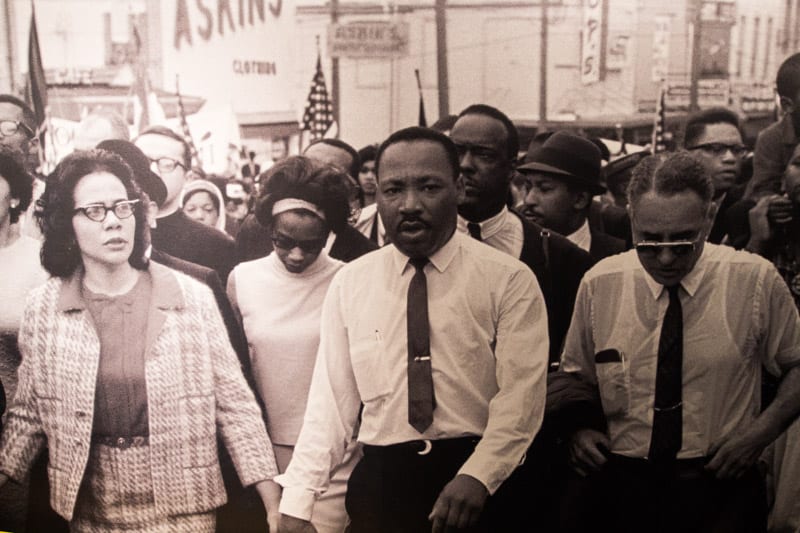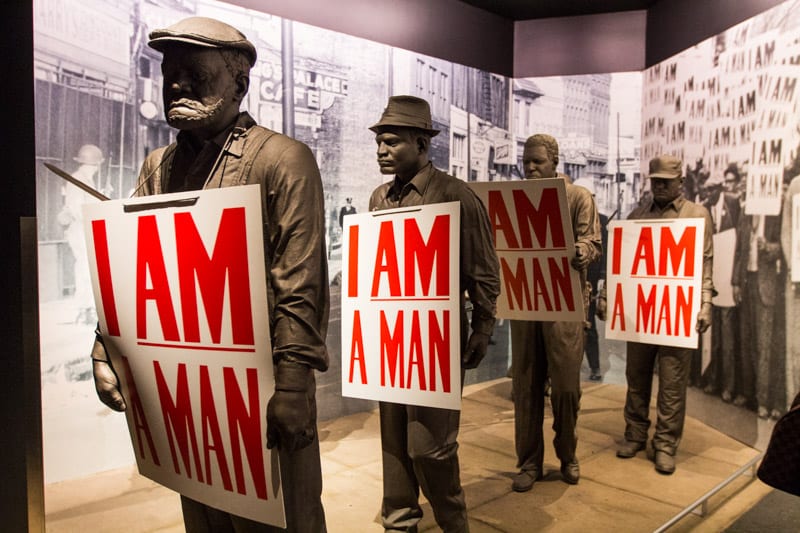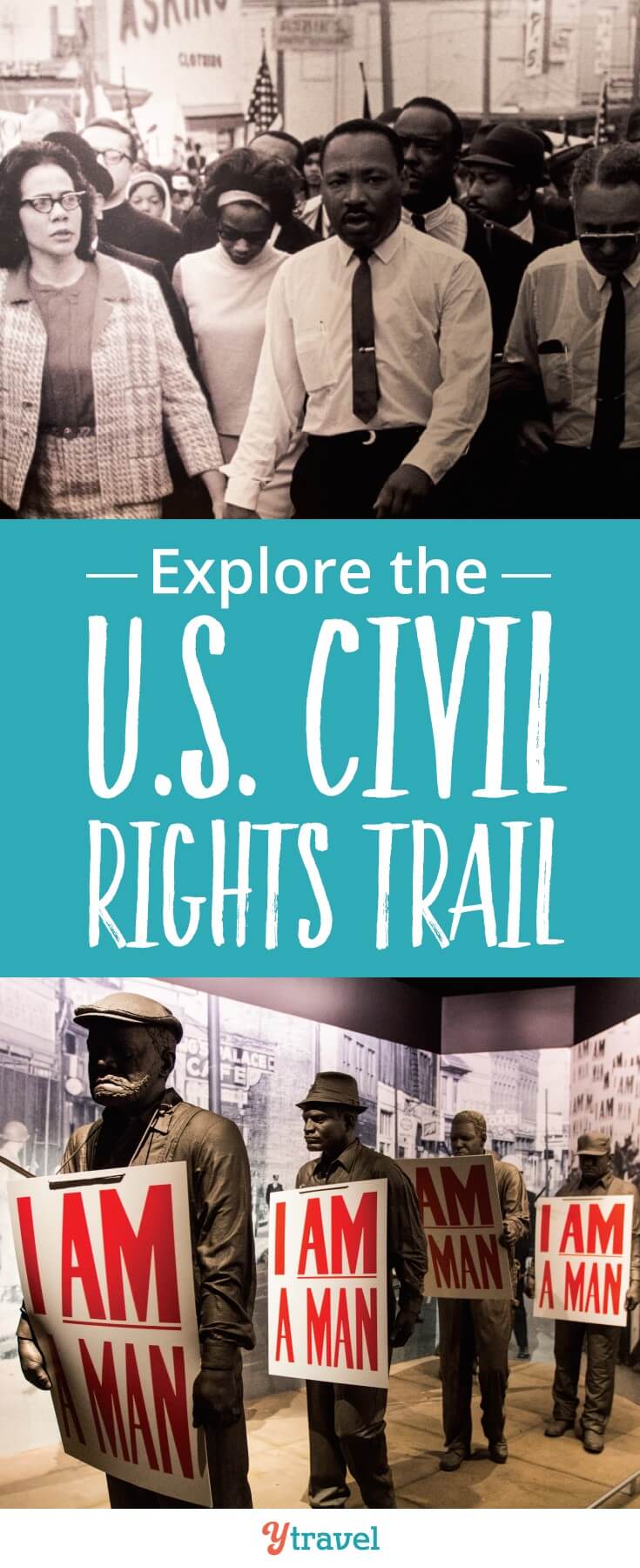This is a sponsored post written by me on behalf of U.S. Civil Rights Trail for IZEA. All opinions are 100% mine.
“Well that’s the dumbest thing I’ve ever heard. Why does that matter?”
Kalyra’s innocent response summed it up perfectly.
I was talking to her about privilege and how some people have more of it than others, purely as a result of where they were born and their skin color.
I struggled to find a response to her very simple and accurate question.
“It doesn’t matter, but unfortunately we live in a world where people can’t see that in their heart due to their own fear and hate. Thankfully, it’s people like Dr. Martin Luther King Jr who helped the world to see that we’re all the same no matter our skin color or the differences between our beliefs. It’s why we visit places like this so we can learn the story, see how hard people fought for equality and continue to work for their mission in our own lives.”
I wasn’t sure how the girls would take the Civil Rights Museum at the Lorraine Hotel in Memphis, but they were attentive, engaged and curious.

As we walked through the story from slavery to the killing of Martin Luther King Jr and beyond, we were able to talk about the inequality and segregation, the power of standing up for what you believe, and how peaceful protests can make incredible changes.
The Museum was so well done and I’m glad we spent several hours in there.
It’s an important conversation to have, even today, when the world “seems” to have equality on the outside. We still have work to do.
Visiting attractions like this on the U.S. Civil Rights Trail helps us to see how far we’ve come, but also how much further we have to go. And the importance of us not dragging our feet or stopping the peaceful movement.
One point I reiterated to my girls during the museum visit was,
“Look at how much they were able to do simply by using peace as their foundation for change.”
I’m honored to publish this post today as we celebrate the Martin Luther King Jr national holiday and his great leadership and inspiration.
What is the U.S. Civil Rights Trail

The U.S. Civil Rights Trail is a collection of over 100 attractions across 14 states.
The attractions include churches, courthouses, schools, museums, and other landmarks in the Southern states and beyond that played a pivotal role in advancing social justice in the 1950s and 1960s, shifting the course of history.
It’s an educational and immersive connection of the events, the people, places and stories that defined the movement.
What a wonderful way to walk in the footsteps of the heroes of the movement and learn from the guides what life was like for those who overcame the adversity so we an better understand who we are and what we have now.
It’s experiencing the stories in real life that help our children, and ourselves, understand.
The Civil Rights movement was instrumental in advancing social justice, not just in the US, but around the world.
My experiences as a teacher have shown me that children find it hard to connect to history and its importance when presented in text books in a classroom filled with distractions.
When children arrive at an attraction, like the Civil Rights Museum, the stories come alive for them and they have meaning.
They can wander through multi media exhibits, or walk through homes of the activists or, and connect to that energy and purpose.
It leaves a longer lasting effect and motivation to be better.
Telling the story of the U.S. Civil Rights Movement

Living in the South gives us ample opportunities to continue the conversation with the girls and visit these historic attractions on the U.S. Civil Rights Trail.
Thanks to the U.S. Civil Rights Trail website, which maps out each of the attractions on the trail, we will be incorporating these attractions on our road trips throughout the South.
I want to reinforce with the girls that bravery, courage and the willingness to peacefully speak out to protect the equality of all is something they have the power to do.
In Raleigh, we have the Martin Luther King Memorial Garden, which we will pay a visit to on Tuesday so we can honor his powerful impact on the world and remember to do our part to keep the dream alive for all of mankind.
Not far from us in Greensboro is the International Civil Rights Center & Museum (Woolworth’s), the place where the very important Greensboro Sit-In happened.
It was a non-violent protest by young African-American students at a segregated Woolworth’s lunch counter in Greensboro, North Carolina, which sparked a sit-in movement that soon spread to college towns throughout the region.
We interacted with a display on this at the Civil Rights Museum.
The girls could not believe that people were not allowed in restaurants because of the color of their skin. They were amazed at the bravery of those students peacefully protesting against it.
Next month, we will be road tripping down to New Orleans and will pass through many of the attractions on the U.S. Civil Rights Trail.
Craig and I visited Martin Luther King Jr’s home at the Martin Luther King Jr. National Historic Site in Atlanta many years ago.
Martin Luther was a hero of mine growing up. He inspired me to live for peace and equality so visiting his home was a memorable highlight of our US travels.
I bought a parchment of his I have a dream speech which I still have at home in a box waiting to be hung on the wall when I finally settle down.
I’d love to help the girls embrace him into the Heroes Hall in their hearts.
Depending on which route we take, I’d also like to visit the Rosa Parks Museum and Civil Rights memorial in Montgomery Alabama.
The Civil Rights Trail is included in our best USA road trip ideas list!
Keep the flame alive

“What happened here changed the world”and it’s important that we keep the flame of that change alive.
Although my parents weren’t in the position to travel with us when I was young, they still did a great job of exposing me to life around the world.
I grew up learning about the Civil Rights Movement and Martin Luther King through documentaries and movies in my home.
It wasn’t something we had lengthy discussions about, but just that exposure opened up in my a thirst to learn more and try to understand.
It also brought heroes into my life like Martin Luther King, something a girl from small town Australia wouldn’t usually be drawn to.
In writing this post, I’ve come to understand how important this was in shaping my character into someone, who like my daughter, thought it was ridiculous that people could be judged and persecuted because of the color of their skin.
I know it had an impact on me wanting to be a better human and it definitely inspired a dream to travel more so I could experience these stories in real life.
Perhaps it’s one reason I was drawn to live in the south.
I’m not sure. But I hope I can open that door for my girls to understand they are not just here for themselves, but to be better humans for the greater good.
Amongst our travel aspirations of hikes in nature, kayaking, delicious ice creams and wild roller coaster rides, we can’t forget to make travel also about education.
Education that helps us to take the pain and the victories of the past to understand how to make a better future.
Pin to Share on Pinterest:
Have you any experience with the attractions on the US. Civil Rights Trail? Which experience do you think we should visit on our trip to New Orleans?


